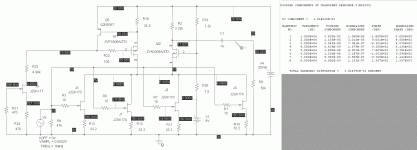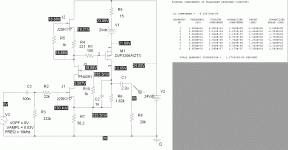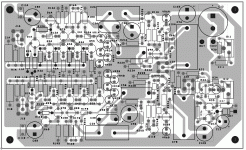This thread started out when I tried a simulation attempting to use a J107 as a low level preamp - it didn't work all that well. I morphed it into a parallel set of 2SK170s similar to the Pearl preamp and did four variations, looking at THD and harmonic distribution. The intent was also to provide enough amplification so that the preamp would serve as the first stage of a passive RIAA preamp, with a ~30X second stage following it and the EQ network. All attempts were cascoded in some way to reduce the amplified Miller capacitance, and to reduce the gate leakage, which sets in at relatively low drain voltage for the 2SK170. I may look at similar structures using the BF862, but not right away. I may not even build any of these very soon, as I don't own a low output MC cartridge, and I have a Denon DL-160 I haven't even opened up (the box is sitting right here on the desk where I'm writing this).
Here's the first attempt.
Here's the first attempt.
Attachments
Hi,
the SK170 as well as the BF862 work well with the 4391, especially as buffer stages, where a rather high valued source resistance doesn´t play a major role.
For an MC-pre stage I´d have an eye on noise figures. Probabely source resistors of 10Ohms or less (even 0Ohm possible, when using matched devices like the LSK389) are needed for sufficiently low noise contribution.
Is the lower capacitance of a cascode really needed? Certainly, if we feed the input via an MM pickup. But isn´t a larger value even a positive feature when feeding the input via an MC?
The current source feeding into the Drains of the JFETs also contributes noise.
Still though an active JFET-ccs (here, probabely the least noisy source among various active ccs) may be preferable to a simple resistor, because of improved PSRR and lower supply voltage level.
For the same reason You might also think about an active JFET ccs load instead of the 2k53 R2 and connecting R2 to gnd instead. Which also gives a nice tuning possibilty to the stage gain.
jauu
Calvin
the SK170 as well as the BF862 work well with the 4391, especially as buffer stages, where a rather high valued source resistance doesn´t play a major role.
For an MC-pre stage I´d have an eye on noise figures. Probabely source resistors of 10Ohms or less (even 0Ohm possible, when using matched devices like the LSK389) are needed for sufficiently low noise contribution.
Is the lower capacitance of a cascode really needed? Certainly, if we feed the input via an MM pickup. But isn´t a larger value even a positive feature when feeding the input via an MC?
The current source feeding into the Drains of the JFETs also contributes noise.
Still though an active JFET-ccs (here, probabely the least noisy source among various active ccs) may be preferable to a simple resistor, because of improved PSRR and lower supply voltage level.
For the same reason You might also think about an active JFET ccs load instead of the 2k53 R2 and connecting R2 to gnd instead. Which also gives a nice tuning possibilty to the stage gain.
jauu
Calvin
I've been cascoding 170s with the PN4391 for years - no new ground for me. The reasons for cascoding are several - first off, to reduce the capacitive loading, as even with a low output, low impedance MC cartridge, I would hesitate to load it with the amplifed miller capacitance of four 2SK170s, especially with the gain I'm contemplating here (~200X). If it was a simple step-up to MM signal levels, it would be a different story. The Pearl preamp uses a bipolar cascode handling all four devices. The transition to exponential gate leakage current happens at a pretty low voltage for 2SK170s. Cascoding fixes that by clamping the drain-source voltage to 4-5 volts, as well as any power dissipation issues. Allocating one cascode per gain device helps reduce the dissipation in the cascode fets. I added a little source resistance to make matching easier and provide a some local feedback. I have both 10 ohm and 20 ohm metal foil resistors coming soon, so I have a choice. I may try simulating with 10 ohms in the source to check out the results. I would also hesitate to place four cascoded 2SK170s in parallel without gate stopper resistors, as that's an oscillator begging to be born.
I don't feel to bad about the 2.53 k resistor, as that's handling the output side of things (~40mV).
The low output MC cartriges in my comfort range ($500-$600) all look to have outputs of 0.3-0.5 mV (I simulated using 0.2), so I could do with somewhat less gain, which would help the distortion.
The last cascode scheme shown is helped a lot by the biasing scheme for the cascode, which clamps the voltage across the resistor and improves supply immunity. I tried this in another thread that examined using a cascoded PN4391 as a preamp, and the distortion was surprisingly good as compared to an active current source.
All these schemes would need a super power supply anyway to exploit their full potential.
I don't feel to bad about the 2.53 k resistor, as that's handling the output side of things (~40mV).
The low output MC cartriges in my comfort range ($500-$600) all look to have outputs of 0.3-0.5 mV (I simulated using 0.2), so I could do with somewhat less gain, which would help the distortion.
The last cascode scheme shown is helped a lot by the biasing scheme for the cascode, which clamps the voltage across the resistor and improves supply immunity. I tried this in another thread that examined using a cascoded PN4391 as a preamp, and the distortion was surprisingly good as compared to an active current source.
All these schemes would need a super power supply anyway to exploit their full potential.
Hi,
With increasingly more difficulties of sourcing genuine 2SK170 and increasing prices, the LSK170 and imho even more so the LSK389 (matched pair) are highly interesting replacement parts. The matching is so well, that even coupling caps at the output of a buffer stage may be obsolete. I just hope that the p-channel LSJ109 will go to market soon.
Since this thread starts with ´musings about..´ I thought I´d throw in a few ideas
jauu
Calvin
Yes, a effect, that is quite often not documented in Datasheets. The BF246, which could otherwise be used as a replacement for the 4391, is also showing this effect. When used with an often to find 1Meg gate-resistor, large amounts of input offset voltage may result.The transition to exponential gate leakage current happens at a pretty low voltage for 2SK170s
Yes again ;-) Some means of grid stopping are necessary. Even more so with the ´faster´ BF862, that may also a good choice for lownoise input stages, because of higher Transmittance Yfs and similarly low noise as the SK170.I would also hesitate to place four cascoded 2SK170s in parallel without gate stopper resistors, as that's an oscillator begging to be born.
With increasingly more difficulties of sourcing genuine 2SK170 and increasing prices, the LSK170 and imho even more so the LSK389 (matched pair) are highly interesting replacement parts. The matching is so well, that even coupling caps at the output of a buffer stage may be obsolete. I just hope that the p-channel LSJ109 will go to market soon.
Nothing to worry about. Sometimes I think its weird, that a simpler solution still sounds ´better´ or more pleasing, even though the electrical parameters und measurements may clearly speak in favour of a more complex alternative.I don't feel to bad about the 2.53 k resistor, as that's handling the output side of things (~40mV).
Since this thread starts with ´musings about..´ I thought I´d throw in a few ideas
jauu
Calvin
I've actually even seen the effect of the gain leakage in simulations where a well placed cascode banishes some pesky offset voltage generated by asymmetrical resistances at the inputs to a power amp's differential stage.
At any rate, the circuits presented were musings that I'm not likely to implement any time soon unless I decide to throw a stand-alone RIAA amp together to ferry 40 miles up the peninsula to audition with Bill Berndt's awesome turntable/MC cartridge combo. Collisions of his setup and my power amps during the last two Burning Amps have been both satisfactory and revealing. He uses a transformer step-up rig that is a little tweaky and hummy, but quite nice when it feels like it. It would be an interesting test to hook an active JFET preamp to his turntable/cartridge. I have no qualms whatsoever about his part of the signal chain.
Oh yeah, I just picked up 100 pieces of 2SK170 from Mouser to augment what I already had in stock, no doubt the last obtainable that way. I should be set for a while, though it would be a good exercise to get a bunch of the Linear Systems alternative to see how they perform - I only have a couple of samples from them from a Burning Amp a couple of years ago.
At any rate, the circuits presented were musings that I'm not likely to implement any time soon unless I decide to throw a stand-alone RIAA amp together to ferry 40 miles up the peninsula to audition with Bill Berndt's awesome turntable/MC cartridge combo. Collisions of his setup and my power amps during the last two Burning Amps have been both satisfactory and revealing. He uses a transformer step-up rig that is a little tweaky and hummy, but quite nice when it feels like it. It would be an interesting test to hook an active JFET preamp to his turntable/cartridge. I have no qualms whatsoever about his part of the signal chain.
Oh yeah, I just picked up 100 pieces of 2SK170 from Mouser to augment what I already had in stock, no doubt the last obtainable that way. I should be set for a while, though it would be a good exercise to get a bunch of the Linear Systems alternative to see how they perform - I only have a couple of samples from them from a Burning Amp a couple of years ago.
Last edited:
Another thought, we never know about the more complex (not very) alternatives until we try them. The distortion readings on the Pearl are about 100X the simulated values I'm reporting here. To be fair, that's the THD + noise, but I want to see if an alternative will listen/measure better. I've been messing with MM circuits for 5+ years - it's time to throw my hat in the MC ring...
Hi wrenchone,
I only had a rough look at circuit #1, but I love your circuits They may have their practical drawbacks (a helper CCS, additional negative rail), but are refreshingly different.
They may have their practical drawbacks (a helper CCS, additional negative rail), but are refreshingly different.
I hope you'll build a prototype and present a full phono stage at some point.
Hannes
I only had a rough look at circuit #1, but I love your circuits
I hope you'll build a prototype and present a full phono stage at some point.
Hannes
This MC input stage looks promising - it's a variant of the Pass Pearl. The difference is that this one allows a gain of 200X in one go, taking the place of the normal first stage of a passively equalized phono preamp. After the EQ, a gain of 30 stage would follow. FYI, that also was the purpose of the circuits previously shown here. I like this one better than some of the earlier offerings, as the high order harmonic content is pushed down more.
I may try this one with my new low output MC cartridge (once I get it set up). With some tweaking, this one might also work well using the BF862 instead of the 2SK170. In that case, I may need a drain resistor on each of the BF862s to prevent them from singing to each other...
I may try this one with my new low output MC cartridge (once I get it set up). With some tweaking, this one might also work well using the BF862 instead of the 2SK170. In that case, I may need a drain resistor on each of the BF862s to prevent them from singing to each other...
Attachments
Hi,
MC stepup design is dominated by noise considerations
not distortion usually, and usually its linear as an input
into a MM stage, for practical commercial success.
However with DIY you can build it as a complete RIAA
stage or replace the first stage of a 2 stage MM circuit.
YMMV but I equate low noise and impedance with BJT's.
rgds, sreten.
MC stepup design is dominated by noise considerations
not distortion usually, and usually its linear as an input
into a MM stage, for practical commercial success.
However with DIY you can build it as a complete RIAA
stage or replace the first stage of a 2 stage MM circuit.
YMMV but I equate low noise and impedance with BJT's.
rgds, sreten.
I'm gunning for both low noise and low distortion, especially as I'm going for a lot of gain with one stage. This probably won't be as low noise as a BJT stage, but the biasing is less problematic, and I'm getting all this with a single-ended stage, compatible with my current setup. My cartridge (in the mail) is good for 0.4 mV, so I could probably tone down the gain on this stage (100X instead of 200X).
Since I have a lot of experimental MM preamps floating around from previous efforts, I'll likely try one of the step-up transformers I have first, and do some mix and match.
Since I have a lot of experimental MM preamps floating around from previous efforts, I'll likely try one of the step-up transformers I have first, and do some mix and match.
Last edited:
I'm looking at something similar to this for the output stage. Gain is 30X, and as can be seen, the distortion is pretty low driven for 900mV output. I may or may not include the input cascode - the circuit is easier to compensate without it.
This stage is non-inverting, so I'll have to reverse the cartridge leads to make all my inputs have the same phase since the input stage is inverting.
This stage is non-inverting, so I'll have to reverse the cartridge leads to make all my inputs have the same phase since the input stage is inverting.
Attachments
I've laid out a preamp for use when I finally have a stable TT setup, using versions of the gain cells shown in posts 13 and 16. I decided on a passive RIAA network between stages using 100nF and 34 nF. Caps are 100nF K-71 Russian polystyrene and 33nF Roederstein 1840 series + 1nF Roederstein 1830 series polypropylene caps.
- Status
- This old topic is closed. If you want to reopen this topic, contact a moderator using the "Report Post" button.
- Home
- Source & Line
- Analogue Source
- Some Musings on a MC Preamp Stage






